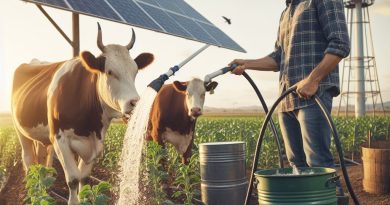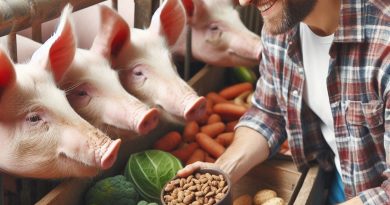Water Management in Livestock Farming
Last Updated on November 20, 2023
Introduction
Let’s explore water management in livestock farming.
Water management in livestock farming plays a crucial role in maintaining the health and productivity of animals.
Adequate water supply is essential for their overall well-being and efficient production.
Water management in livestock farming refers to the strategies and practices implemented to ensure a sufficient and clean water supply for animals.
It involves proper storage, distribution, and conservation methods.
Water is a vital nutrient for livestock as it helps maintain normal body functions such as digestion, temperature regulation, and nutrient absorption.
Adequate water intake ensures optimum growth, milk production, and reproduction.
Water is also crucial for maintaining animal welfare and preventing diseases.
Clean and hygienic water reduces the risk of bacterial and parasitic infections, urinary issues, and dehydration.
Furthermore, water scarcity or poor quality can negatively impact livestock productivity and farm profitability.
Insufficient water supply leads to reduced feed consumption, weight loss, and decreased milk yield.
It can also hinder the proper assimilation of nutrients and impede the effectiveness of vaccines and medications.
Implementing effective water management practices is essential for livestock farms to maximize their productivity, prevent health issues, and ensure the welfare of animals.
Regular monitoring, adequate infrastructure, and conservation techniques are key to achieving efficient water usage on farms.
In fact, water management in livestock farming is crucial for the health, productivity, and welfare of animals.
Providing clean and sufficient water supply is essential to support proper body functions and optimize growth, reproduction, and milk production.
Proper water management practices are vital for the success and sustainability of livestock farms.
Understanding Water Requirements for Livestock
Different water needs for different livestock species
- Cattle: Cows and bulls require the most water among livestock species due to their large size.
- Sheep and goats: These smaller animals need less water compared to cattle but still require an adequate supply.
- Poultry: Chickens and other poultry birds have relatively low water requirements but still need access to clean water.
- Swine: Pigs have moderate water needs, and their consumption depends on factors such as age and weight.
Factors affecting water consumption in livestock
- Environmental temperature: Higher temperatures increase water intake in livestock.
- Feed type and quality: Animals consuming dry feed or consuming high-fiber diets require more water.
- Milk production: Lactating livestock, especially dairy cows, need additional water to support milk production.
- Pregnancy and lactation: Pregnant and nursing animals have increased water requirements.
- Exercise and activity levels: Livestock engaging in physical activity require more water to stay hydrated.
- Water quality and availability: Clean, fresh, and easily accessible water sources promote higher water intake.
Everyday water requirements per animal
- Cattle: Adult cattle may consume between 8 to 20 gallons (30 to 76 liters) of water per day.
- Sheep and goats: These animals typically drink around 2 to 4 gallons (7.6 to 15 liters) of water daily.
- Poultry: Chickens require about 0.25 to 0.5 gallons (1 to 2 liters) of water every day.
- Swine: Pigs can drink anywhere from 2 to 5 gallons (7.6 to 19 liters) of water per day, depending on their size.
Ensuring adequate water supply for livestock is crucial for their overall health and productivity.
As a livestock farmer, it is essential to understand the specific water needs of each species and provide them with sufficient and accessible water sources.
By doing so, you can prevent dehydration, improve feed utilization, and promote optimal growth and development.
Different water needs for different livestock species
Different livestock species have varying water requirements due to factors such as size, diet, and physiological processes.
Cattle, being the largest livestock, have the highest water needs. They can consume between 8 to 20 gallons (30 to 76 liters) of water per day.
On the other hand, smaller animals like sheep and goats need around 2 to 4 gallons (7.6 to 15 liters) of water daily.
Factors affecting water consumption in livestock
Apart from species, various factors influence the water consumption of livestock.
Environmental temperature plays a significant role, as higher temperatures lead to increased water intake.
This is because animals regulate their body temperature through perspiration and evaporation, requiring more water to compensate for the loss.
Additionally, feed type and quality affect water needs. Animals consuming dry or high-fiber diets necessitate more water to aid digestion.
Milk production is another factor that impacts water consumption.
Lactating livestock, especially dairy cows, require additional water to support the production of milk.
Pregnancy and lactation also increase water requirements as maternal animals need to meet the demands of their offspring.
Likewise, the level of physical activity affects water intake.
Livestock engaged in exercise or labor-intensive tasks must be adequately hydrated to prevent dehydration and exhaustion.
To ensure proper water management, livestock farmers must provide clean, fresh, and easily accessible water sources.
Animals are more likely to consume water if it is of good quality and readily available.
Regularly cleaning troughs, buckets, or automatic watering systems is crucial to prevent contamination and promote water intake.
By understanding the water requirements of livestock and considering the influencing factors, farmers can optimize their management practices.
Adequate water supply supports nutrient absorption, assists in temperature regulation, and helps maintain overall health.
Provision of sufficient water sources for livestock leads to improved feed utilization, growth rates, and reproduction.
In brief, water management in livestock farming is vital for maintaining the well-being and productivity of animals.
Different livestock species have distinct water needs, influenced by factors such as temperature, feed type, and physical activity.
Providing the right quantity and quality of water is essential to promote optimal growth and development in livestock.
Farmers should prioritize accessible clean water sources and monitor consumption to ensure the welfare of their animals.
Read: Agri Solar Panels: Powering Farms Sustainably
Sources of Water for Livestock
Natural Sources: Rivers, Lakes, and Ponds
In arid regions, relying on nature’s bounty is challenging.
Rivers, when present, offer a consistent water source, vital for sustaining livestock.
Lakes and ponds, although subject to seasonal fluctuations, serve as reliable reservoirs.
Man-Made Sources: Wells, Boreholes, and Water Storage Systems
- Wells: Delve into the earth’s depths to tap into groundwater. Routine maintenance guarantees a continuous supply.
- Boreholes: Drill deep for groundwater access, ensuring a steady water flow to meet livestock demands.
- Water Storage Systems: Employ tanks or reservoirs to store water. Essential for times when natural sources falter.
Ensuring Water Quality and Availability
- Water Testing: Regularly assess water quality for contaminants. Collaborate with local authorities for comprehensive testing.
- Infrastructure Maintenance: Keep wells and boreholes in optimal condition. Regular cleaning and repairs are imperative.
- Water Quantity Management: Implement water-efficient systems. Monitor and adjust usage to prevent shortages during peak demand.
A robust water management strategy for livestock farming involves a dual focus on natural and man-made sources.
By ensuring quality, availability, and sustainable practices, farmers safeguard the well-being of their livestock while promoting the longevity of their operations.
Read: Livestock Record Keeping: Tips for Efficiency

Water Conservation Strategies in Livestock Farming
Water conservation in livestock farming is crucial to ensure sustainable and efficient use of this precious resource.
By implementing various strategies and techniques, farmers can significantly reduce water wastage while maintaining the health and productivity of their animals.
Efficient watering systems and equipment
Efficient watering systems and equipment play a vital role in water conservation.
Traditional water troughs and open ponds can result in excessive evaporation and contamination.
Livestock farmers can opt for modern alternatives such as automatic waterers and drip irrigation systems.
These systems minimize water loss through evaporation and provide controlled water access to animals.
Moreover, they reduce the risk of water contamination by preventing direct animal contact with water sources.
Implementing proper water management techniques
Implementing proper water management techniques is essential to optimize water use in livestock farming.
Farmers should closely monitor water consumption and have a clear understanding of the hydration needs of their animals.
By tracking the amount of water consumed, farmers can identify potential issues, ensure adequate water supply, and avoid unnecessary wastage.
Additionally, proper watering schedules and practices, such as avoiding excessive overflow or run-off, can help conserve water resources.
Preventing water wastage through leak detection and repair
Preventing water wastage through leak detection and repair is another crucial aspect of water management in livestock farming.
Regular inspection of water systems, including pipes, tanks, and valves, is necessary to identify any leaks or damages.
Promptly fixing these leaks can prevent significant water loss and ensure efficient water distribution.
Additionally, using high-quality materials during construction or repair can reduce the likelihood of future leaks and minimize water wastage.
Rainwater harvesting for livestock watering
Rainwater harvesting for livestock watering is an eco-friendly and cost-effective approach to conserve water.
Farmers can collect rainwater through various methods, such as storing it in tanks or creating ponds.
This harvested water can then be utilized for watering livestock, reducing the reliance on freshwater sources.
Rainwater harvesting also helps in reducing the risk of soil erosion and enhances groundwater recharge, contributing to overall environmental sustainability.
In essence, water conservation strategies are essential for maintaining sustainability in livestock farming.
Efficient watering systems, proper water management techniques, leak detection, repair, and rainwater harvesting all play significant roles in minimizing water wastage.
By implementing these strategies, farmers can ensure a more efficient use of water resources while promoting the well-being of their animals and the environment.
Read: Eco-Friendly Livestock Farming Techniques
Ensuring Water Safety for Livestock
Regular water testing and monitoring
Regular water testing and monitoring are crucial in maintaining the safety of water sources for livestock.
This helps identify any potential contaminants or pollutants present in the water.
By consistently testing the water, farmers can detect harmful substances and take necessary actions to protect the health of their livestock.
This includes checking for bacteria, viruses, chemicals, and minerals that may affect the animals.
Proper monitoring also allows farmers to assess the quality and quantity of water available to their livestock.
This helps in planning the necessary measures to ensure an adequate supply of clean water for the animals.
Addressing waterborne diseases and parasites
Waterborne diseases and parasites pose a significant risk to livestock health.
Farmers must take proactive measures to prevent and control these threats.
Regular vaccinations, deworming, and parasite control programs are essential in minimizing the risk of waterborne diseases.
This includes monitoring livestock behavior, appearance, and overall health to identify any signs of illness caused by contaminated water.
Ensuring proper drainage and wastewater management systems are in place also helps prevent the accumulation of standing water, which can become a breeding ground for parasites and disease-causing organisms.
Best practices for water disinfection and treatment
Effective water disinfection and treatment are necessary to eliminate potential contaminants and ensure the safety of livestock drinking water.
Chemical disinfection methods, such as chlorination and ozonation, can effectively kill bacteria, viruses, and parasites present in the water.
Regular maintenance of disinfection systems is essential to ensure the proper functioning of these treatment methods.
Physical treatment methods, such as filtration and sedimentation, can remove suspended particles and sediments, improving water clarity and reducing potential health risks for animals.
Training and educating farmers on water safety measures
Training and educating farmers on water safety measures are vital in promoting sustainable water management practices in livestock farming.
Implementing proper hygiene practices, such as cleaning and sanitizing water troughs and storage tanks, can help prevent bacterial growth and contamination of drinking water.
Providing farmers with information about the potential risks associated with poor water quality and the importance of regular testing and monitoring can encourage them to prioritize water safety.
Farmers should also be educated on the proper use of disinfection and treatment methods to ensure they are implemented correctly and effectively.
Overall, ensuring water safety for livestock is crucial for their health and well-being.
Regular testing, addressing waterborne diseases, adopting best practices for water disinfection, and educating farmers are key steps in achieving this goal.
Read Managing Livestock Stress: Strategies & Tips
Economic and Environmental Benefits of Effective Water Management
In livestock farming, effective water management not only contributes to the overall sustainability of the farm but also offers various economic and environmental advantages.
Reducing Water-Related Costs in Livestock Farming
Implementing efficient water management strategies can greatly reduce the costs associated with water usage in livestock farming.
- By monitoring and controlling water consumption, farmers can identify areas of excessive usage and make necessary adjustments.
- Investing in technologies like automated water systems and water recycling can significantly lower water bills.
- Efficient watering systems, such as drip irrigation, can help minimize water wastage, resulting in long-term cost savings.
Minimizing Water Pollution and Preserving Natural Resources
Effective water management practices play a pivotal role in reducing water pollution and preserving precious natural resources.
- Implementing proper waste management strategies prevents contaminants from entering water sources, safeguarding both animal and human health.
- By employing techniques like land and water management, farmers can protect nearby rivers and streams from harmful runoff and excessive sediments.
- Efficient irrigation methods, such as precision agriculture, ensure that only the required amount of water is used, minimizing water depletion.
Positive Impact on Overall Farm Sustainability
Adopting effective water management techniques has a positive impact on the overall sustainability of livestock farming operations.
- Conserving water resources improves the long-term viability of the farm and helps farmers adapt to changing climatic conditions.
- Water efficiency measures can enhance the productivity and efficiency of livestock operations, leading to improved farm profitability.
- Maintaining clean and abundant water sources ensures the well-being and health of both animals and plants.
- By showcasing sustainable practices, farmers can strengthen their reputation and attract environmentally conscious consumers.
In a nutshell, effective water management in livestock farming brings considerable economic and environmental benefits.
It reduces water-related costs, minimizes water pollution, preserves natural resources, and positively impacts overall farm sustainability.
By adopting these practices, farmers can create a more efficient and sustainable future for their operations.
Conclusion
Throughout this blog post, we have explored the importance of water management in livestock farming.
We have highlighted the need for proper water supply, quality, and efficient usage.
Proper water management is vital in livestock farming due to its direct impact on animal health, productivity, and overall farm sustainability.
Neglecting water management can lead to various issues, including disease outbreaks and decreased profitability.
To ensure successful water management, farmers are encouraged to employ effective strategies like regular monitoring, proper infrastructure, and water conservation techniques.
It is crucial to prioritize the health and well-being of animals while also considering environmental concerns.
By implementing these practices, farmers can enhance their farm’s productivity, reduce costs, and contribute to a sustainable water future.
Let us all play our part in responsible water management in livestock farming.


